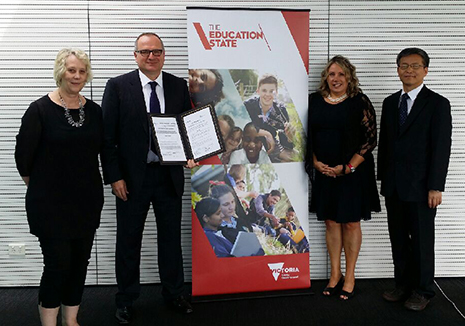News
Global LYNCs is an innovative technology project that is helping to develop connections between school children in Victoria, Australia and Daegu, Republic of Korea.
Global LYNCs uses ZOOM, a freely available internet-based telecommunications tool as well as laptop webcams, microphones and HD Video Conferencing Units. All students can use the project without having to purchase expensive equipment.
The technology is used for a variety of exchange projects. For example, during one science lesson a Google Docs spreadsheet was shared and classes from Australia and Korea plotted solar meridian data from their respective hemispheres to compare differences. Korean students also experienced a virtual excursion to the Sydney Opera House.
The online interaction is only the beginning of the cultural exchange. 'Students enjoy sharing their cultures and actively engage in music, art, dance and sport demonstrations including taekwondo, cricket and football. Gifts such as traditional costumes and games are posted and form the basis of some of the curriculum activities,' says Joanne Tate, Senior Project Officer with Victorian Department of Education and Early Childhood Development.
The Global LYNCs project also helps develop staff skills with training provided to new schools in the use of technology. Some internationally combined teacher meetings and workshops are also organised throughout the year using the telecommunications and a number of school visits.
Formal participant evaluations are conducted each year. A project blog and electronic newsletter is used to share information and celebrate news of the project. Teachers are able to share teaching resources, rubrics and lesson plans on the blog. Schools are encouraged to look for common areas of curriculum with their partners.
Currently, 34 Victorian and Korean classrooms connect on a regular basis. The project has grown substantially in its second year thanks to the support of the Australia-Korea Foundation. The Education Department is seeking interest from additional Australian schools to meet a growing demand from schools in Korea.
'The grant helps facilitate telecommunication opportunities by supporting the licensing of virtual rooms that can accommodate a range of school based dial in devices,' says Joanne.
'This has meant that schools can now utilise existing expensive HD Units with real purpose. Digital communications, school visits, teacher training and in person collaboration with the Daegu District Office for annual planning is also supported by the grant.'
In Victoria, the 'Framework for Improving Student Outcomes'mentionsCommunity Engagement in Learning: Global Citizenship. For a school to be 'excelling' they need to meet the following criteria:
Schools and their communities are globally engaged and establish and sustain international partnerships that provide students with a deep understanding of the world and rich experiences of other cultures, aligned to curricula and learning objectives. Students collaborate in shared learning activities with peers in other countries.
By these criteria, Global LYNCs classrooms are excelling. The project has demonstrated an increase in cross-cultural understanding between Australia and Korea. Through the project, three participating schools in South Western Victoria now offer a Korean language program.
A number of schools in other regions have also found Global LYNCs to be a natural complement to their existing Korean language programs. Two other participating schools are currently considering the introduction of the language. There has also been a generation of interest that has led to visits and teacher participation in the UNESCO Republic of Korea teacher exchange program.
Global LYNCs is supported by the Australia-Korea Foundation, which was established by the Australian Government in 1992 to promote bilateral relations between Korea and Australia.


